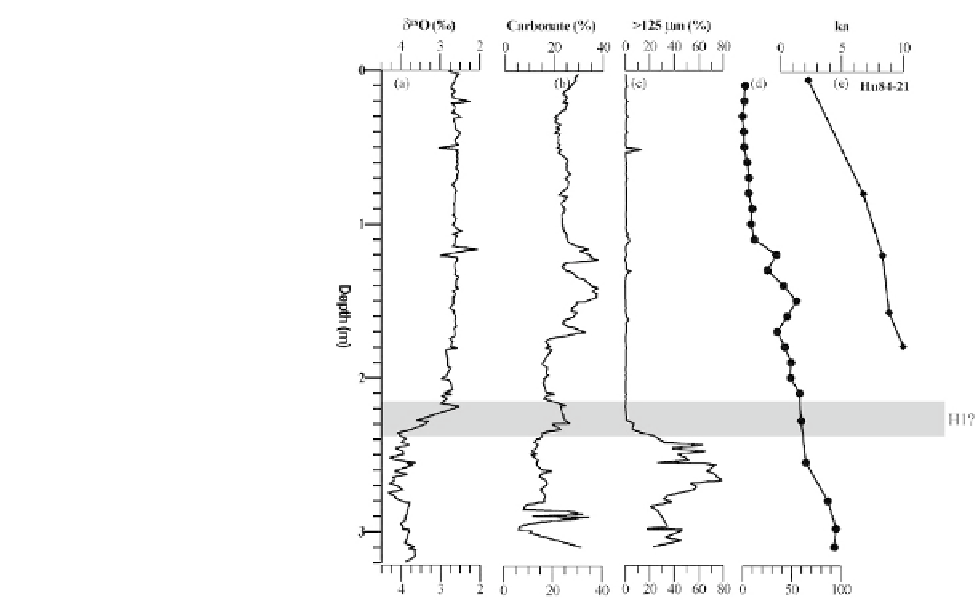Geoscience Reference
In-Depth Information
18
OonN. pachyderma (s),
Figure 6.
Core Hu84-21 from the lower slope off Okak Trough with down-core plots of (a)
δ
agellate species Brigantedinium spp. (%), and (e)
14
C-AMS (ka B.P.) versus
depth (m). The core was retrieved at 2853 m water depth. Horizontal gray bar denotes H1(?). Two high-carbonate beds
between 1.2 and 1.55 m were interpreted as the Agassiz drainage event by Hillaire-Marcel et al. [2007], while the high-
carbonate event centered at 1.7 m was correlated to the 10.2 ka freshwater forcing event [Rashid et al., 2008].
(b) carbonate (%), (c) >125 µm (%), (d) dino
from marine records of the northeastern Atlantic [Wael- l -
broeck et al., 2002; Bondevik et al., 2006; Peck et al.,
2008]. In addition, it is possible that the extension of the ice
shelf and sea ice cover in the Labrador Sea may have de-
creased the ocean-atmospheric exchange further, thus in-
creasing the duration of the
et al., 1993; Rashid and Boyle, 2007]. On the other hand, the
sedimentation rates in between the H events, such as during
the Last Glacial Maximum or in the intervals from 460 to 470
and 865 to 875 cm in cores Hu97-16 and Hu97-09, respec-
tively, are extremely low, consistent with the previous
nd-
ings of Hillaire-Marcel et al. [1994]. In summary, the high
sedimentation rate cores from the northwest Labrador Sea
allowed us unambiguous identi
R.
Two
14
C-AMS dates in core Hu97-09 at 241 and 256 cm
are statistically identical (Table 1). Although the 1
Δ
uncer-
tainty of 160 years is high for such a young date, given the
small (119 years) age reversal, we do not have any strong
reason to discard it. The 14,870 ± 160
14
C year at 461 cm
between two dates of 13,130 ± 40 and 13,600 ± 110
14
C year
(Table 1 and Figure 3) shows stratigraphic reversal, and we
suspect that it is contaminated by older carbon [Rashid et al.,
2003b]. Taking the rest of the
14
C-AMS dates at face value, it
shows that the sedimentation rates in cores Hu97-16 and
Hu97-09 abruptly increased during both H0 and H1, result-
ing in beds 50 to 100 and 90 to 380 cm in thickness, respec-
tively. In contrast, equivalent thicknesses of H0 and H1 vary
from merely 5 to 20 cm in the open North Atlantic [Grousset
σ
cation of H1 and H0.
14
C-AMS dates of H layers were obtained at 5
-
10 cm below the bottom boundary to avoid contamination
by reworked sediments, and as a result, our basal dates are
always older than the accepted dates for the onset of
H layers. This assertion is based on the recently revised
Greenland Ice Core Chronology 2005 (GICC05) [Rasmussen
et al., 2006; Svensson et al., 2008], where the positions of the
stadials/interstadials and hence the H events are clearly con-
strained. Other ages determined within the H layers may
have a minor in
Some
uence of old carbon. For these reasons, and
because of the uncertainties in
R, our dates cannot be used
to estimate the duration of H events.
Δ









Search WWH ::

Custom Search